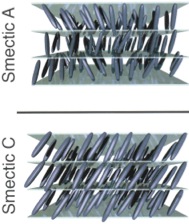Experimental Soft Matter Physics
Jamming
We recently became interested in the phenomenon of jamming, thanks to our work on liquid crystalline suspensions of cellulose nanocrystals (CNCs). It turns out that, if you concentrate a typical aqueous CNC suspension, it will enter a gel-like state beyond a concentration of 15% or so. From a physics point of view it is, however, not a gel, because there is no long-range connectivity between the rods at this stage (there is no percolation). The system instead enters this kinetically arrested, non-equilibrium jammed state thanks to a kind of 'electrostatic caging' [1] between the electrostatically stabilized CNC rods: because of the repulsion between the many closely spaced neighbor CNC rods at concentrations around the jamming threshold, they can no longer move to accommodate to changes in the environment, resulting in the gel-like character.
This jamming event is quite interesting, because it traps the self-assembled chiral nematic liquid crystal-ordered state, preventing disordered aggregation as the remaining water evaporates [2]. However, a better understanding of the balance between liquid crystal formation and jamming is needed in order to control the process. This is a main focus in our research on suspensions of cellulose nanocrystals, from which photonic crystal films can be produced by water evaporation if the parameters are chosen wisely.
[1] K. Kang, and J.K.G. Dhont, Phys. Rev. Lett., 110, 1, 015901 (2013)
[2] Jan Lagerwall, Christina Schütz, Michaela Salajkova, JungHyun Noh, Ji Hyun Park, Giusy Scalia and Lennart Bergström NPG Asia Materials, 6, e80, doi:10.1038/am.2013.69 (2014), open access
 Back to research overview.
Back to research overview.